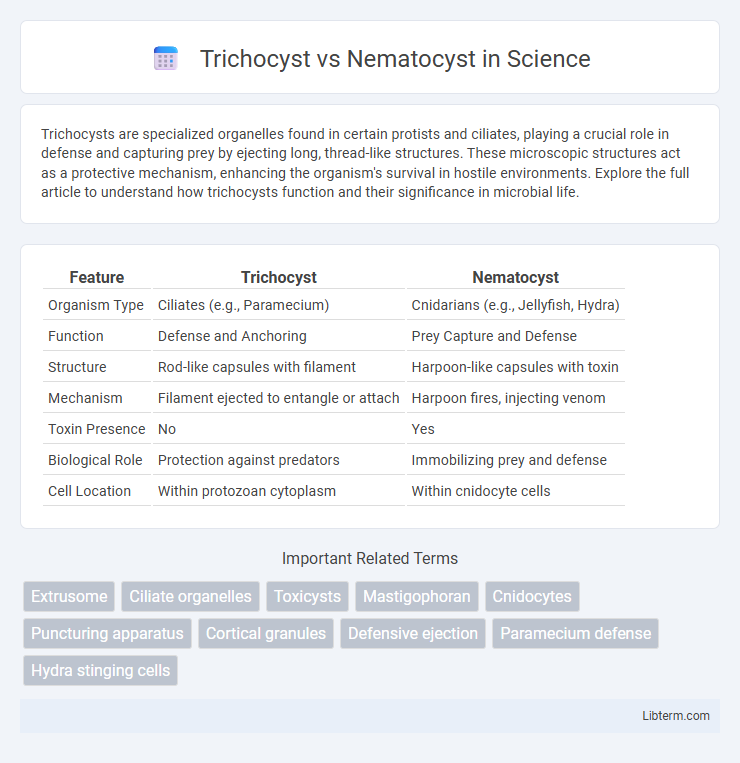Trichocysts are specialized organelles found in certain protists and ciliates, playing a crucial role in defense and capturing prey by ejecting long, thread-like structures. These microscopic structures act as a protective mechanism, enhancing the organism's survival in hostile environments. Explore the full article to understand how trichocysts function and their significance in microbial life.
Table of Comparison
| Feature | Trichocyst | Nematocyst |
|---|---|---|
| Organism Type | Ciliates (e.g., Paramecium) | Cnidarians (e.g., Jellyfish, Hydra) |
| Function | Defense and Anchoring | Prey Capture and Defense |
| Structure | Rod-like capsules with filament | Harpoon-like capsules with toxin |
| Mechanism | Filament ejected to entangle or attach | Harpoon fires, injecting venom |
| Toxin Presence | No | Yes |
| Biological Role | Protection against predators | Immobilizing prey and defense |
| Cell Location | Within protozoan cytoplasm | Within cnidocyte cells |
Introduction to Trichocysts and Nematocysts
Trichocysts and nematocysts are specialized organelles found in different aquatic microorganisms, serving defensive and predatory functions. Trichocysts, primarily found in ciliates such as Paramecium, discharge thread-like structures to deter predators or capture prey, while nematocysts, characteristic of cnidarians like jellyfish and sea anemones, contain venomous harpoons used for immobilizing prey and protection. Both structures represent evolutionary adaptations for survival in aquatic environments, with nematocysts being more complex in mechanism and effect due to their role in envenomation.
Definition of Trichocyst
Trichocysts are specialized secretory organelles found in ciliates, acting as defensive structures that discharge filamentous threads when threatened. Unlike nematocysts in cnidarians, which are stinging cells used for prey capture and protection, trichocysts primarily function to anchor or shield the organism. Their mechanism involves the sudden ejection of a proteinaceous thread that can entangle or deter predators.
Definition of Nematocyst
Nematocysts are specialized stinging organelles found in cnidarians such as jellyfish and sea anemones, used for defense and prey capture by delivering toxins through a barbed, coiled thread. In contrast, trichocysts are ejectable organelles in ciliates like Paramecium that release thread-like structures primarily for protection and anchoring. The nematocyst's ability to inject venom distinguishes it functionally and structurally from trichocysts, which do not possess venom-secreting properties.
Structural Differences
Trichocysts are elongated, rod-shaped organelles found in ciliates, composed mainly of a fibrous protein matrix that can rapidly eject filamentous threads for defense or anchoring purposes. Nematocysts, present in cnidarians, consist of a capsule containing a coiled, barbed, and venomous thread capable of ejecting explosively to immobilize prey or deter predators. The key structural difference lies in the nematocyst's specialized explosive capsule and venom apparatus, contrasted with the simpler filamentous discharge mechanism of trichocysts.
Mechanism of Action
Trichocysts discharge by rapidly ejecting a thread-like structure that physically entangles or anchors prey, relying on a mechanical extrusion mechanism triggered by irritation or chemical stimuli. Nematocysts function through a high-pressure osmotic process, explosively releasing a harpoon-like tubule coated with venom to penetrate and immobilize prey or deter predators. The key difference lies in trichocysts' defensive entanglement versus nematocysts' venomous injection facilitated by specialized cellular architecture.
Biological Functions
Trichocysts and nematocysts serve distinct biological functions in protists and cnidarians, respectively. Trichocysts function primarily in defense and prey capture by rapidly ejecting filamentous structures to deter predators or immobilize prey. Nematocysts operate as specialized stinging organelles that deliver venom through a harpoon-like mechanism, facilitating both protection and prey subjugation in organisms like jellyfish and sea anemones.
Organisms Containing Trichocysts
Organisms containing trichocysts primarily include certain ciliates, such as Paramecium, which utilize these specialized organelles for defense and capturing prey. Trichocysts are spindle-shaped structures embedded in the cytoplasm that can discharge filament-like projections upon stimulation. Unlike nematocysts found in cnidarians, trichocysts are devoid of toxins and primarily function as mechanical deterrents rather than venomous stinging cells.
Organisms Containing Nematocysts
Nematocysts are specialized stinging organelles primarily found in Cnidarians, including jellyfish, sea anemones, and corals, enabling these organisms to capture prey and defend against predators. Trichocysts, in contrast, are extrusion organelles located in ciliates like Paramecium, serving mainly for defense by releasing filamentous structures. The presence of nematocysts is a defining characteristic of the phylum Cnidaria, crucial for their predatory and protective mechanisms.
Ecological and Evolutionary Significance
Trichocysts and nematocysts serve distinct ecological roles and highlight evolutionary adaptations in protists and cnidarians, respectively. Trichocysts in ciliates function primarily in defense and prey capture through rapid extrusion, enhancing survival in microhabitats with predatory threats. Nematocysts, specialized stinging organelles unique to cnidarians, evolved for effective prey immobilization and defense, playing a crucial role in their ecological dominance and diversification in aquatic ecosystems.
Summary: Trichocyst vs Nematocyst
Trichocysts and nematocysts are specialized organelles found in protozoans and cnidarians, respectively, serving defense and predation functions. Trichocysts, located in ciliates like Paramecium, discharge filamentous structures for protection or anchoring, while nematocysts in jellyfish and sea anemones explosively release harpoon-like threads capable of injecting venom. The key difference lies in their composition and mechanism: trichocysts are proteinaceous and offer physical defense, whereas nematocysts are complex capsules designed for capturing prey and deterring predators through envenomation.
Trichocyst Infographic

 libterm.com
libterm.com